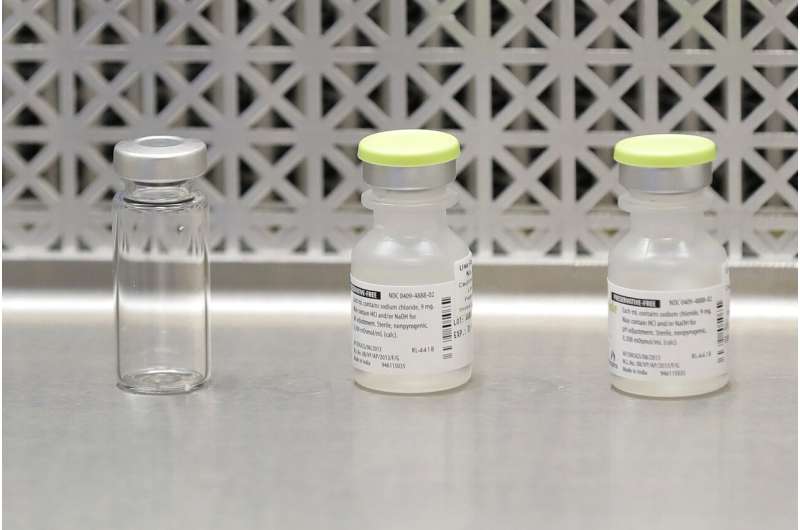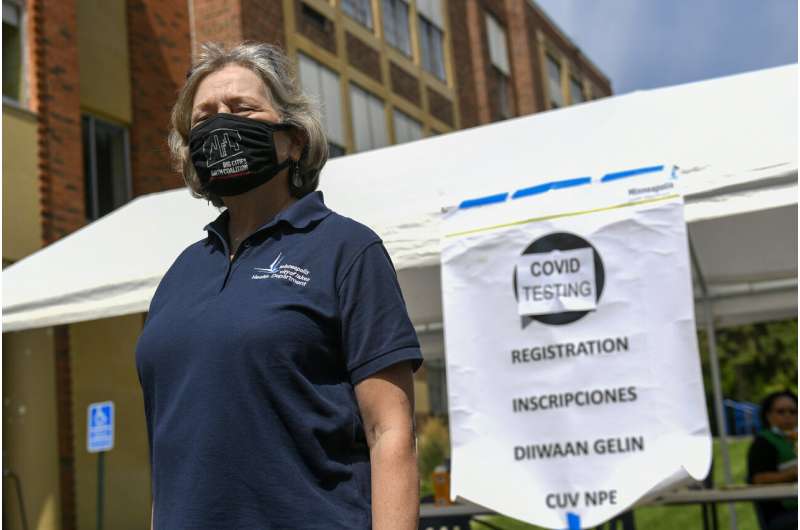This March 16, 2020 file photo shows vials used by pharmacists to prepare syringes used on the first day of a first-stage safety study clinical trial of the potential vaccine for COVID-19, the disease caused by the new coronavirus, in Seattle. As the nation awaits a vaccine to end the pandemic, local health departments say they lack the staff, money and tools to distribute, administer and track millions of vaccines, most of which will require two doses. (AP Photo/Ted S. Warren, File)
Public health departments, which have struggled for months to test and trace everyone exposed to the novel coronavirus, are now being told to prepare to distribute COVID-19 vaccines as early as Nov. 1.
In a health departments that have been only about half of Americans saying they would get vaccinated, according to a poll from AP-NORC Center for Public Affairs Research, it also will be crucial to educate people about the benefits of vaccination, said Molly Howell, who manages the North Dakota Department of Health's immunization program.
The unprecedented pace of vaccine development has left many Americans skeptical about the safety of COVID-19 immunizations; others simply don't trust the federal government.
"We're in a very deep-red state," said Ann Lewis, CEO of CareSouth Carolina, a group of community health centers that serve mostly low-income people in five rural counties in South Carolina. "The message that is coming out is not a message of trust and confidence in medical or scientific evidence."
PAYING FOR THE ROLLOUT
The U.S. has committed more than underfunded and without adequate resources to confront the coronavirus pandemic. The investigation further found that federal coronavirus funds have been slow to reach public health departments, forcing some communities to cancel non-coronavirus vaccine clinics and other essential services.
States are allowed to use some of the federal money they've already received to prepare for immunizations. But AP and KHN found that many health departments are so overwhelmed with the current costs of the pandemic—such as for testing and contact tracing—that they can't reserve money for the vaccine work to come. Health departments will need to hire people to administer the vaccines and systems to track them, and pay for supplies such as protective medical masks, gowns and gloves, as well as warehouses and refrigerator space.
Minneapolis Health Commissioner Gretchen Musicant poses for a portrait at a COVID-19 testing event at Incarnation-Sagrado Corazon Church on Aug. 15, 2020, in Minneapolis. The $150 billion that states and local governments received from the Coronavirus Relief Fund only covers expenses made through the end of the year, says Musicant. That's a problem, given distribution of a possible vaccine may not have even begun. (AP Photo/Craig Lassig)
CareSouth Carolina is collaborating with the state health department on testing and the pandemic response. It used federal funding to purchase $140,000 retrofitted vans for mobile testing, which it plans to continue to use to keep vaccines cold and deliver them to residents when the time comes, said Lewis.
But most vaccine costs will be new.
Pima County, Arizona, for example, is already at least $30 million short of what health officials need to fight the pandemic, let alone plan for vaccines, said Dr. Francisco Garcia, deputy county administrator and chief medical officer.
Some federal funds will expire soon. The $150 billion that states and local governments received from a fund in the CARES Act, for example, covers only expenses made through bidding against one another for a limited supply. Those concerns are amplified by the continuing difficulties providing enough testing kits; supplying health workers with personal protective equipment; allocating drugs such as remdesivir; and recruiting contact tracers—who track down everyone with whom people diagnosed with COVID-19 have been in contact.
Although Ehresmann said she's concerned Minnesota could run out of syringes, she said the CDC has assured her it will provide them.
Given that vaccines are far more complex than personal protective equipment and other medical supplies—one vaccine candidate must be stored at minus 94 degrees Fahrenheit—Plescia said people should be prepared for shortages, delays and mix-ups.
"It's probably going to be even worse than the problems with testing and PPE," Plescia said.
© 2020 The Associated Press. All rights reserved. This material may not be published, broadcast, rewritten or redistributed without permission.

























